汽车灯光控制
- 格式:doc
- 大小:935.00 KB
- 文档页数:23
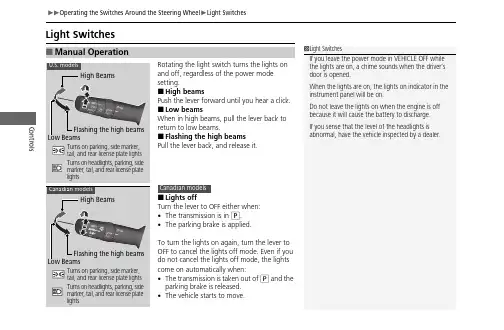
Controls Light SwitchesRotating the light switch turns the lights onand off, regardless of the power modesetting.■High beamsPush the lever forward until you hear a click.■Low beamsWhen in high beams, pull the lever back toreturn to low beams.■Flashing the high beamsPull the lever back, and release it.■Lights offTurn the lever to OFF either when:•The transmission is in P.•The parking brake is applied.To turn the lights on again, turn the lever toOFF to cancel the lights off mode. Even if youdo not cancel the lights off mode, the lightscome on automatically when:•The transmission is taken out of P and theparking brake is released.•The vehicle starts to move.■Manual Operation1Light SwitchesIf you leave the power mode in VEHICLE OFF whilethe lights are on, a chime sounds when the driver’sdoor is opened.When the lights are on, the lights on indicator in theinstrument panel will be on.Do not leave the lights on when the engine is offbecause it will cause the battery to discharge.If you sense that the level of the headlights isabnormal, have the vehicle inspected by a dealer.Flashing the high beamsLow BeamsFlashing the high beamsLow BeamsCanadian modelsControlsAutomatic lighting control can be used when the power mode is in ON.When the light switch is in AUTO , theheadlights and other exterior lights will switch on and off automatically depending on the ambient brightness.The headlights comes on when you unlock a door in dark areas with the headlight switch in AUTO .u Once you lock the door, the headlights will go off.■Automatic Operation (automatic lighting control)1Automatic Operation (automatic lighting control)We recommend that you turn on the lights manually when driving at night, in a dense fog, or in dark areas such as long tunnels or parking facilities.The light sensor is in the location shown below.Do not cover this light sensor with anything;otherwise, the automatic lighting system may notwork properly.Light SensorModels without automaticintermittent wipersLight SensorModels with automatic intermittent wipers*Controls The headlights automatically come on when the wipers are used several times withina certain number of intervals with the headlight switch in AUTO.The headlights automatically go off a few minutes later if the wipers are stopped.The headlights, all other exterior lights, and the instrument panel lights turn off 15seconds after you set the power mode to VEHICLE OFF, take the remote with you,and close the driver’s door.If you set the power mode to VEHICLE OFF with the headlight switch on, but do notopen the door, the lights turn off after 10 minutes (three minutes, if the switch is inthe AUTO position).The lights turn on again when you unlock or open the driver’s door. If you unlockthe door, but do not open it within 15 seconds, the lights go off. If you open thedriver’s door, you will hear a reminder chime alerting you that the lights are on.Fog Lights*When the low beam headlights are on, turnthe fog light switch on to use the fog lights.■Headlight Integration with Wipers■Automatic Lighting Off Feature1Automatic Operation (automatic lighting control)You can adjust the auto light sensitivity as follows:SettingThe exterior lights come onwhen the ambient light is atMaxHighMidLowMinU.S. modelsBrightDark1Headlight Integration with WipersThis feature activates while the headlights are off inAUTO.The instrument panel brightness does not changewhen the headlights come on.At dark ambient light levels, the automatic lightingcontrol feature turns on the headlights, regardless ofthe number of wiper sweeps.1Automatic Lighting Off FeatureYou can change the headlight auto off timer setting.Fog Light SwitchControlsAuto High-BeamThe front sensor camera detects the light sources ahead of the vehicle such as the lights of a preceding or oncoming vehicle, or street lights. When you are driving at night, the system automatically switches the headlights between low beam and high beam depending on the situation.When all of the following conditions have been met, the auto high-beam indicator comes on and the auto high-beam is activated.•The power mode is in ON.•The light switch is in AUTO .•The lever is in the low beam position.•The headlights have been automatically activated.•It is dark outside the vehicle.If the auto high-beam indicator does not come on even when all the conditions have been met, carry out the following procedure and the indicator will come on.•Pull the lever toward you for flashing the high beams then release it while driving.1Auto High-BeamThe auto high-beam system does not always operate in every situation. This system is just for assisting the driver. Always observe your surroundings and switch the headlights between high beam and low beam manually if necessary.If you find the timing of beam changes inconvenient for driving, change the headlight beams manually.The range and the distance at which the camera can recognize varies depending on conditions surrounding your vehicle.Regarding the handling of the camera mounted to the inside of the windshield, refer to the following.2Front Sensor Camera For the auto high-beam to work properly:•Do not place an object that reflects light on the dashboard.•Keep the windshield around the camera clean.•When cleaning the windshield, be careful not to apply the windshield cleanser to the camera lens.•Do not attach an object, sticker or film to the area around the camera.•Do not touch the camera lens.If the camera receives a strong impact, or repairing of the area near the camera is required, consult a dealer.■How to Use the Auto High-BeamFront Sensor CameraAuto High-Beam IndicatorLight SwitchControls ■Automatic switching between high-beam and low-beamWhen auto high-beam is active, the headlights switch between high beam and lowbeam based on the following conditions.■Manual switching between high-beam and low-beamIf you want to manually switch the headlights between high beam and low beam,follow either of the procedures below. Note that when you do this, the auto high-beam indicator will turn off and the auto high-beam will be deactivated.Using the lever:Pull the lever toward you for flashing the high beams then release it within aboutone second while driving.u To reactivate the auto high-beam, pull the lever toward you for flashing thehigh beams then release it while driving. The auto high-beam indicator willcome on.Using the light switch:Turn the light switch to .u To reactivate the auto high-beam, turn the light switch to AUTO when theSwitching to high beam:Switching to low beam:All of the following conditions mustbe met before the high beams turnon.●Your vehicle speed is 25 mph (40km/h) or more.●There are no preceding oroncoming vehicle with headlightsor taillights turned on.●There are few street lights on theroad ahead.One of the following conditionsmust be met before the low beamsturn on.●Your vehicle speed is 15 mph (24km/h) or less.●There is a preceding or oncomingvehicle with headlights ortaillights turned on.●There are many street lights onthe road ahead.1How to Use the Auto High-BeamIn the following cases, the auto high-beam systemmay not switch the headlights properly or theswitching timing may be changed. In case of theautomatic switching operation does not fit for yourdriving habits, please switch the headlights manually.•The brightness of the lights from the preceding oroncoming vehicle is intense or poor.•Visibility is poor due to the weather (rain, snow,fog, windshield frost, etc.).•Surrounding light sources, such as street lights,electric billboards and traffic lights are illuminatingthe road ahead.•The brightness level of the road ahead constantlychanges.•The road is bumpy or has many curves.•A vehicle suddenly appears in front of you, or avehicle in front of you is not in the preceding oroncoming direction.•Your vehicle is tilted with a heavy load in the rear.•A traffic sign, mirror, or other reflective objectahead is reflecting strong light toward the vehicle.•The oncoming vehicle frequently disappears underroadside trees or behind median barriers.•The preceding or oncoming vehicle is a motorcycle,bicycle, mobility scooter, or other small vehicle.The auto high-beam system keeps the headlight lowbeam when:•Windshield wipers are operating at a high speed.•The camera has detected a dense fog.ControlsYou can turn the auto high-beam system off. If you want to turn the system off or on, set the power mode to ON, then carry out the following procedures while the vehicle is stationary.To turn the system off:With the light switch is in AUTO , pull the levertoward you and hold it for at least 40 seconds. After the auto high-beam indicator light blinks twice, release the lever.To turn the system on:With the light switch is in AUTO , pull the lever toward you and hold it for at least 30 seconds. After the auto high-beam indicator light blinks once, release the lever.■How to Turn Off the Auto High-Beam1How to Use the Auto High-BeamIf the Some Driver Assist Systems CannotOperate: Camera Temperature Too High message appears:•Use the climate control system to cool down the interior and, if necessary, also use defroster mode with the airflow directed toward the camera.•Start driving the vehicle to lower the windshield temperature, which cools down the area around the camera.If the Some Driver Assist Systems Cannot Operate: Clean Front Windshield message appears:•Park your vehicle in a safe place, and clean the windshield. If the message does not disappear after you have cleaned the windshield and driven for a while, have your vehicle checked by a dealer.1How to Turn Off the Auto High-BeamIf you turn the auto high-beam system off, the system does not operate until you turn the system on.Park in a safe place before turning the system off oron.。
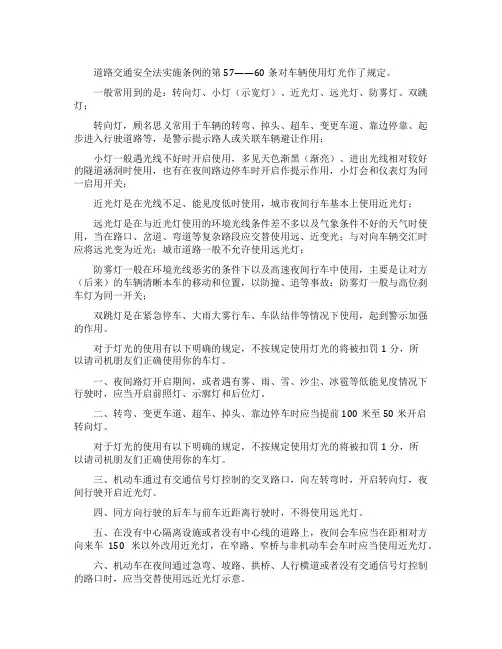
道路交通安全法实施条例的第57——60条对车辆使用灯光作了规定。
一般常用到的是:转向灯、小灯(示宽灯)、近光灯、远光灯、防雾灯、双跳灯;转向灯,顾名思义常用于车辆的转弯、掉头、超车、变更车道、靠边停靠、起步进入行驶道路等,是警示提示路人或关联车辆避让作用;小灯一般遇光线不好时开启使用,多见天色渐黑(渐亮)、进出光线相对较好的隧道涵洞时使用,也有在夜间路边停车时开启作提示作用,小灯会和仪表灯为同一启用开关;近光灯是在光线不足、能见度低时使用,城市夜间行车基本上使用近光灯;远光灯是在与近光灯使用的环境光线条件差不多以及气象条件不好的天气时使用,当在路口、岔道、弯道等复杂路段应交替使用远、近变光;与对向车辆交汇时应将远光变为近光;城市道路一般不允许使用远光灯;防雾灯一般在环境光线恶劣的条件下以及高速夜间行车中使用,主要是让对方(后来)的车辆清晰本车的移动和位置,以防撞、追等事故;防雾灯一般与高位刹车灯为同一开关;双跳灯是在紧急停车、大雨大雾行车、车队结伴等情况下使用,起到警示加强的作用。
对于灯光的使用有以下明确的规定,不按规定使用灯光的将被扣罚1分,所以请司机朋友们正确使用你的车灯。
一、夜间路灯开启期间,或者遇有雾、雨、雪、沙尘、冰雹等低能见度情况下行驶时,应当开启前照灯、示廓灯和后位灯。
二、转弯、变更车道、超车、掉头、靠边停车时应当提前100米至50米开启转向灯。
对于灯光的使用有以下明确的规定,不按规定使用灯光的将被扣罚1分,所以请司机朋友们正确使用你的车灯。
三、机动车通过有交通信号灯控制的交叉路口,向左转弯时,开启转向灯,夜间行驶开启近光灯。
四、同方向行驶的后车与前车近距离行驶时,不得使用远光灯。
五、在没有中心隔离设施或者没有中心线的道路上,夜间会车应当在距相对方向来车150米以外改用近光灯,在窄路、窄桥与非机动车会车时应当使用近光灯。
六、机动车在夜间通过急弯、坡路、拱桥、人行横道或者没有交通信号灯控制的路口时,应当交替使用远近光灯示意。
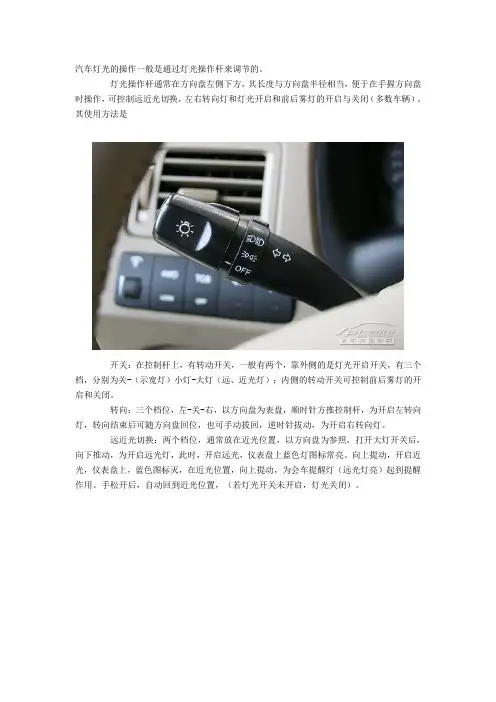
汽车灯光的操作一般是通过灯光操作杆来调节的。
灯光操作杆通常在方向盘左侧下方,其长度与方向盘半径相当,便于在手握方向盘时操作,可控制远近光切换,左右转向灯和灯光开启和前后雾灯的开启与关闭(多数车辆)。
其使用方法是开关:在控制杆上,有转动开关,一般有两个,靠外侧的是灯光开启开关,有三个档,分别为关-(示宽灯)小灯-大灯(远、近光灯);内侧的转动开关可控制前后雾灯的开启和关闭。
转向:三个档位,左-关-右,以方向盘为表盘,顺时针方推控制杆,为开启左转向灯,转向结束后可随方向盘回位,也可手动拔回,逆时针拔动,为开启右转向灯。
远近光切换:两个档位,通常放在近光位置,以方向盘为参照,打开大灯开关后,向下推动,为开启远光灯,此时,开启远光,仪表盘上蓝色灯图标常亮。
向上提动,开启近光,仪表盘上,蓝色图标灭,在近光位置,向上提动,为会车提醒灯(远光灯亮)起到提醒作用。
手松开后,自动回到近光位置,(若灯光开关未开启,灯光关闭)。
汽车照明系统是否进行正确的指向调整,不仅关乎实际的照射效果,也关乎车辆行驶的安全,大街上经常能看到一些车的近光灯调得很高,使对面车辆产生眩光,非常影响安全。
同时,如果不能正确调节车大灯指向,也会影响车大灯的照射范围,以及路面的照射效果。
即使是更换一些升级的卤素灯泡,也最好检查一下车大灯是否正确指向,因为灯丝位置的细微变化,也会导致车大灯光型的巨大变化。
下面的调整汽车照明系统方法不需要借助特殊的设备和仪器,但却能获得正确的指向照明。
需要准备的东西:卷尺、封口胶,十字螺丝和内六角套筒步骤1:首先,找到一块地面水平且又有垂直白色墙面的场地――地下停车场里就很好。
正对白色墙面,将车直着慢慢开过去,并在车头最大限度贴近墙面的位置停住。
在墙面上对应车头中心线的位置(对”MM“,就是中网的头标中心点),划一条垂直线(注:为了避免涂鸭别人的墙面,我建议用胶带黏贴,方便去除)。
然后,直线倒车,在车头灯距离墙面25英尺处停住(即约7.6米处)步骤2:进行如下两项测量测量A:测量车灯外罩的几何中心点到地面的高度测量B:近光灯透镜的中心点到车头中心点(对“MM”而言,就是中网的车标中心点)的距离,以及远光灯中心点到车头中心点的距离步骤3:在墙面上,划出两条水平线(可以用胶带黏贴取代,下同),一条对应步骤2中的测量A值,即头灯中心到地面的高度,另一条则比上面的高度低2英寸(即约5厘米)。


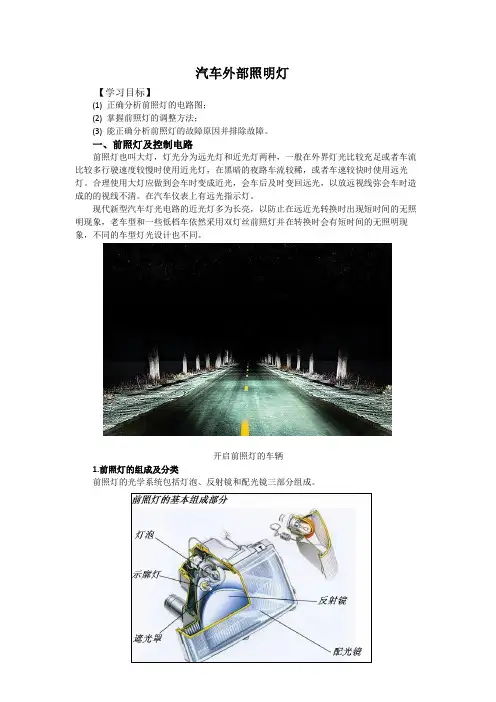
汽车外部照明灯【学习目标】(1)正确分析前照灯的电路图;(2)掌握前照灯的调整方法;(3)能正确分析前照灯的故障原因并排除故障。
一、前照灯及控制电路前照灯也叫大灯,灯光分为远光灯和近光灯两种,一般在外界灯光比较充足或者车流比较多行驶速度较慢时使用近光灯,在黑暗的夜路车流较稀,或者车速较快时使用远光灯。
合理使用大灯应做到会车时变成近光,会车后及时变回远光,以放远视线弥会车时造成的的视线不清。
在汽车仪表上有远光指示灯。
现代新型汽车灯光电路的近光灯多为长亮,以防止在远近光转换时出现短时间的无照明现象,老车型和一些低档车依然采用双灯丝前照灯并在转换时会有短时间的无照明现象,不同的车型灯光设计也不同。
开启前照灯的车辆1.前照灯的组成及分类前照灯的光学系统包括灯泡、反射镜和配光镜三部分组成。
前照灯总成的结构一般可分为全封闭式和半封闭式两种。
1)封闭式前照灯结构这种前照灯由于将灯泡、配光镜、反射镜集合一体,当灯丝烧断时需要整体更换,成本较高。
导致这种结构被淘汰。
封闭式大灯结构2)半封闭式前照灯结构这种前照灯结构特点是将反射镜、配光镜组合安装,保持密封性,杜绝尘土进入前照灯。
将灯泡分离,可进行单独更换。
结构科学,目前市场上大多车辆都使用这种大灯结构。
半封闭式大灯结构又细分分为反射式、和投射式两种结构。
其中反射式指传统半封闭大灯结构。
反射式半封闭大灯结构3) 投射式大灯结构投射式前照灯一般和氙气灯泡组合使用,和传统半封闭式大灯结构相比只是多了一组凸透镜装置。
投射式大灯结构意识图氙气灯泡位于椭圆反光镜中心,反光镜反光焦点和凸透镜的焦点重叠。
从而把光线直射到车前方,它的光线利用率更高,是普通反射式前照灯的2倍。
因此现代中高端汽车很多已经采用这种结构,为投射式前照灯总成的解剖图。
投射式前照灯总成解剖图2. 前照灯的灯泡:现代轿车前照灯灯泡主要有两种:卤素灯泡和氙气灯。
按灯丝的数量可分为单丝灯和双丝灯。
前照灯的分类(1)卤钨灯泡:卤钨灯泡俗称为卤素灯泡,它是在惰性气体中加入了一定量的卤族元素。
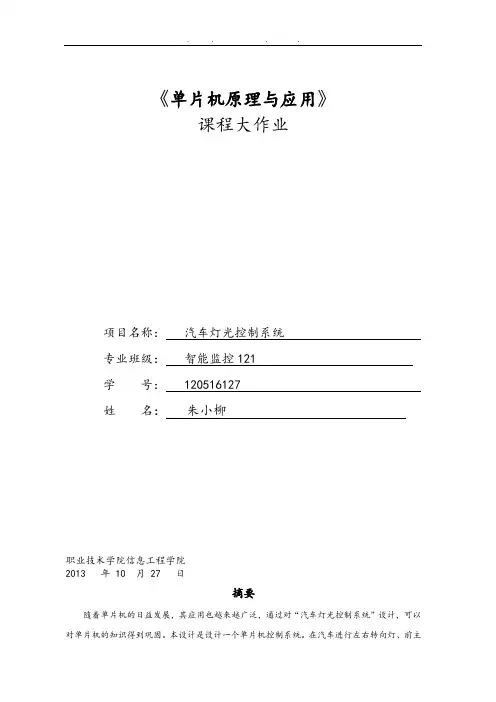
《单片机原理与应用》课程大作业项目名称:汽车灯光控制系统专业班级:智能监控121学号: 120516127姓名:朱小柳职业技术学院信息工程学院2013 年 10 月 27 日摘要随着单片机的日益发展,其应用也越来越广泛,通过对“汽车灯光控制系统”设计,可以对单片机的知识得到巩固。
本设计是设计一个单片机控制系统。
在汽车进行左右转向灯、前主灯、倒车灯、故障灯时,实现对各种信号指示灯的控制。
本设计主要是对单片机的并行输入、输出口电路的应用,通过对I/O口控制发光二极管的亮、灭、闪烁,加上一些复位电路、按键电路、驱动电路来模拟汽车尾灯的功能。
关键词单片机;汽车信号灯;电路基础;绪论车灯是行车安全的必备件,除了具有照明作用,对行人和其他车辆还具有转向、会车、刹车等警示作用。
其中汽车转向灯的控制就是一例。
汽车转向和报警信号灯是汽车运动方向和车身状态的表示信号,关系着汽车的安全问题,因此基于单片机的汽车转向灯控制器的一直以来都是汽车电子设计中的一个十分重要的领域。
此次基于单片机的汽车转向灯的设计中,复位电路的设计、LED发光二极管的应用、4个按键开关、键盘扫描来控制LED灯点亮的方式都基本符合课程设计的要求。
其中复位电路的作用是当单片机死机的情况下用来复位重启单片机,软件部分主要是用键盘扫描的方式来与程序中的设定值比较如果一致就执行该段子程序来实现LED的点亮方式。
汽车上的信号灯有:转向灯(左前灯、右前灯、仪表盘上的二个指示灯)。
当汽车转弯、倒车、停靠时,转向灯发出不同的信号。
目前国广泛使用电热式闪光器产生闪光信号。
闪烁频率在 50~110 次/ min,但是一般控制在 60~95 次min 之间。
闪光器是通过调节镍铬丝的拉力和触点的间隙来满足频率要求的,灯泡功率的大小也会影响闪烁频率。
因此在更换闪光器或灯泡时调整比较困难。
同时,系统没有故检测,驾驶员无法知道车外的转向灯与示宽灯是否点亮,从而影响行车安全。
到目前为止,我们还没有发现能检测灯丝断这种故障的有效方法。
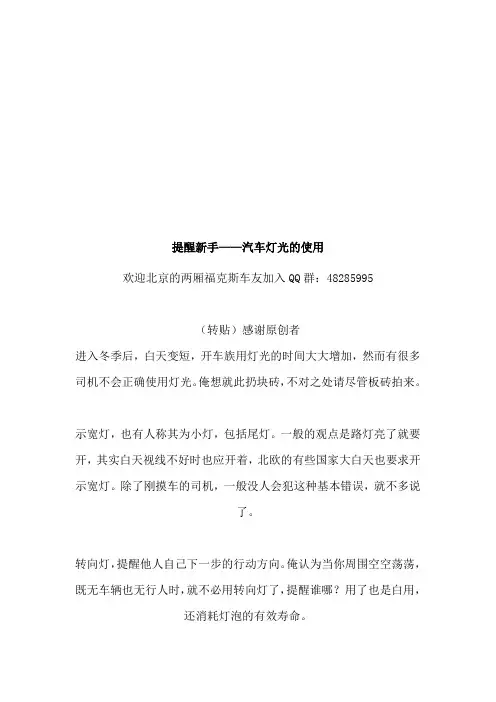
提醒新手——汽车灯光的使用欢迎北京的两厢福克斯车友加入QQ群:48285995(转贴)感谢原创者进入冬季后,白天变短,开车族用灯光的时间大大增加,然而有很多司机不会正确使用灯光。
俺想就此扔块砖,不对之处请尽管板砖拍来。
示宽灯,也有人称其为小灯,包括尾灯。
一般的观点是路灯亮了就要开,其实白天视线不好时也应开着,北欧的有些国家大白天也要求开示宽灯。
除了刚摸车的司机,一般没人会犯这种基本错误,就不多说了。
转向灯,提醒他人自己下一步的行动方向。
俺认为当你周围空空荡荡,既无车辆也无行人时,就不必用转向灯了,提醒谁哪?用了也是白用,还消耗灯泡的有效寿命。
近光灯。
用于照亮自己前面的路。
由于投射角度低,照亮的距离有限,但只要不是高速行驶,完全够用。
近光灯关键是不会直射对面的司机和路人,也不会使自己前方同向行驶的车辆驾驶员被反光镜中的强烈反光搞得眼花缭乱。
俺认为近光灯可以像示宽灯一样大胆地使用。
不过,在照明良好的路段,俺经常是不开近光灯的,理由会在本贴的最后提到。
远光灯。
同样用于照亮自己前面的路,但请司机们慎用。
由于投射角度高,照亮的距离很远,对面的司机和路人会被照得看不见东西,自己前方同向行驶的车辆驾驶员也会被反光镜中的强烈反光搞得眼花缭乱,可能的后果是不言而喻的。
因此,只有当对面没有车辆行人,而且自己前方很远的地方才有同向行驶的车辆时才可开启远光灯。
当然,用闪远光灯的方式提醒他人是没有问题的。
有一个例外,如果看到捷达车像开着远光灯时,估计你要原谅这位司机了,这种情况绝大多数时候不是司机的错,因为捷达车的后排坐人或后背箱负重时,就会车尾下沉车头上翘,以至于近光灯像远光灯那样,这是捷达车的天生缺陷。
真不知道一汽大众对捷达车进行了多次改进,可就是不改这很致命的缺陷,对得起中国这么多的捷达车爱好者吗?对得起自己的良心吗?俺真有心喊“打倒”了。
雾灯,也有叫防雾灯的,这是需要特别说明的一种灯光。
请列位看官注意这种灯的名字,雾灯顾名思义是雾天(也包括雨雪天气)才使用的灯,由于其结构、灯光颜色及功率等原因,穿透能力很强。
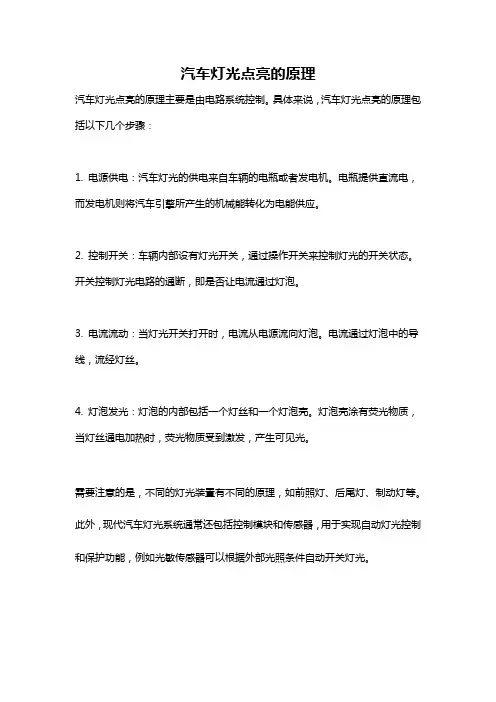
汽车灯光点亮的原理
汽车灯光点亮的原理主要是由电路系统控制。
具体来说,汽车灯光点亮的原理包括以下几个步骤:
1. 电源供电:汽车灯光的供电来自车辆的电瓶或者发电机。
电瓶提供直流电,而发电机则将汽车引擎所产生的机械能转化为电能供应。
2. 控制开关:车辆内部设有灯光开关,通过操作开关来控制灯光的开关状态。
开关控制灯光电路的通断,即是否让电流通过灯泡。
3. 电流流动:当灯光开关打开时,电流从电源流向灯泡。
电流通过灯泡中的导线,流经灯丝。
4. 灯泡发光:灯泡的内部包括一个灯丝和一个灯泡壳。
灯泡壳涂有荧光物质,当灯丝通电加热时,荧光物质受到激发,产生可见光。
需要注意的是,不同的灯光装置有不同的原理,如前照灯、后尾灯、制动灯等。
此外,现代汽车灯光系统通常还包括控制模块和传感器,用于实现自动灯光控制和保护功能,例如光敏传感器可以根据外部光照条件自动开关灯光。
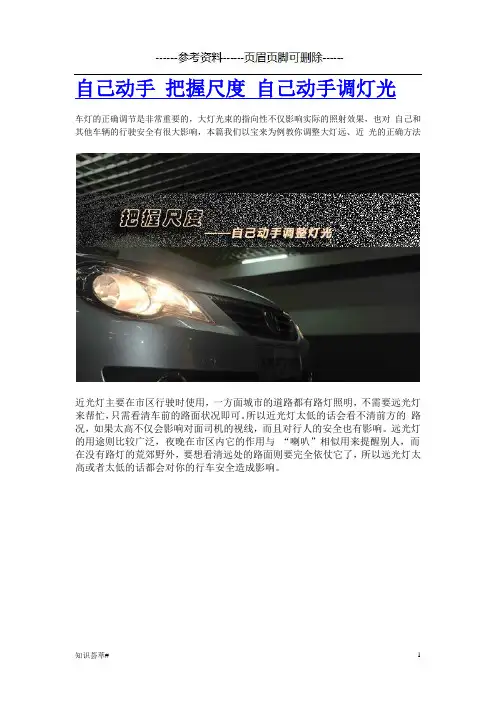
自己动手把握尺度自己动手调灯光
车灯的正确调节是非常重要的,大灯光束的指向性不仅影响实际的照射效果,也对自己和其他车辆的行驶安全有很大影响,本篇我们以宝来为例教你调整大灯远、近光的正确方法
近光灯主要在市区行驶时使用,一方面城市的道路都有路灯照明,不需要远光灯来帮忙,只需看清车前的路面状况即可。
所以近光灯太低的话会看不清前方的路况,如果太高不仅会影响对面司机的视线,而且对行人的安全也有影响。
远光灯的用途则比较广泛,夜晚在市区内它的作用与“喇叭”相似用来提醒别人,而在没有路灯的荒郊野外,要想看清远处的路面则要完全依仗它了,所以远光灯太高或者太低的话都会对你的行车安全造成影响。
【01 准备工具】
■选择地点:
找一块没有车辆、地面平整同时又有垂直墙面的场地,地下停车场是最好的选择。
■调灯光的工具(配图1)
1.一块厚实的毛巾
2.十字改锥
3.长一点的米尺
4.白色或彩色胶条。
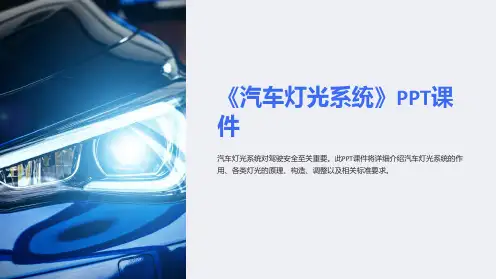
汽车前照灯(大灯)电路控制的形式及分析方法汽车前照灯控制电路有些是比较复杂的,电路的分析及电流的走向,在汽车电路的故障诊断中起着非常重要的作用。
为了帮助读者及维修人员搞清楚各电路的流向及控制方法,现将一些常见的前照灯控制电路(控制火线式带大灯继电器和变光继电器、控制搭铁式带大灯继电器和变光继电器、只带大灯继电器的控制形式大灯控制电路、带远光和近光继电器的大灯控制形式大灯控制电路、没有继电器的火线控制式大灯控制电路、没有继电器的控制搭铁式的大灯控制电路)及电流控制电路,给出详尽的电路分析方法,节省大量的时间,资料非常难得宝贵,无论是对修理工和教师,都有很大的帮助作用。
一、带大灯继电器和变光继电器大灯控制电路1. 控制火线式(1)大灯不工作时(2)前照灯继电器工作电路当灯光开关接通后,其电路是:蓄电池正极→易熔线FL→灯光开关→灯光继电器通电线圈→搭铁→蓄电池负极左前照灯远光灯工作电路当灯光开关接通时,其电路是:蓄电池正极→易熔线FL→灯光继电器的触点K1→变光继电器的触点K2→保险丝A→左远光灯→搭铁→蓄电池的负极。
右前照灯远光灯工作电路蓄电池正极→易熔线FL→灯光继电器的触点K1→变光继电器的触点K2→保险丝A→W点→右远光灯→搭铁→蓄电池的负极。
远光指示灯电路当灯光开关接通时,其电路是:蓄电池正极→易熔线FL →灯光继电器的触点K 1→变光继电器的触点K 2→保险丝A →W 点→Q 点→远光指示灯→搭铁→蓄电池的负极。
当接通变光开关时,左右前照灯的近光灯电路接通: 左前照灯近光灯工作电路蓄电池正极→易熔线FL →灯光继电器的触点K 1→变光继电器的触点K 2→保险丝B →左近光灯→搭铁→蓄电池的负极。
右前照灯近光灯工作电路远光指示灯变光继电器灯光继电器灯光开关远光左近光右变光开关K 1→ →→→ →→ → →→K 2→→ QFL保险丝A保险丝B→远光W→→→ →→→ →→→→→→ → →→→ →→→ 近光蓄电池正极→易熔线FL →灯光继电器的触点K 1→变光继电器的触点K 2的下触点→保险丝B →右近光灯→搭铁→蓄电池的负极。
汽车车灯图解大全(一)示廓灯的使用及操作 (1)(二)近、远光灯的使用及操作 (3)(三)雾灯的使用及操作 (6)(四)日间行车灯的使用及操作 (8)(五)双闪灯的运用及操作 (9)(六)制动灯的运用及操作 (11)(七)牌照灯的使用及操作 (11)(八)倒车灯的使用及操作 (12)(九)转向灯的使用及操作 (13)(十) 阅读灯的使用方法 (15)(一)示廓灯的使用及操作示廓灯示廓灯定义:示廓灯也叫示宽灯,俗称小灯。
光从字面上看,“示”是警示的意思;“廓”有轮廓之意,所以示廓灯是一种警示标志的车灯,用来提醒其它车辆注意的示意灯。
这种灯一般安装在汽车顶部的边缘处,这既能表示汽车高度又能表示宽度。
安全标准规定在车高高于三米的汽车必须安装示廓灯。
示廓灯使用:示廓灯的颜色为前白后红,如下图所示,将灯光开关开至第一挡时,前后亮的灯就是示廓类。
示廓灯用于在傍晚行驶时,让别的车辆看见。
当你从后视镜看不清楚后边的时候,就该点亮小灯,特别是下雨天。
但是很多司机会用示廓灯代替近光灯在黑暗中行车,这是很危险的,因为示宽灯并无法照亮前方道路。
《交通法》相关规定:第六十条机动车在道路上发生故障或者发生交通事故,妨碍交通又难以移动的,应当按照规定开启危险报警闪光灯并在车后50米至100米处设置警告标志,夜间还应当同时开启示廓灯和后位灯。
夜间发生故障或事故未开示廓灯和后位灯的罚款200。
(二)近、远光灯的使用及操作近光灯、远光灯近光灯定义:近光灯就是为了近距离照明,设计要求就是照射范围大(160°),照射距离短,聚光度也无法调节。
近光灯的照射距离约有30-40米左右。
远光灯的照射高度比近光灯要高,因此能够照亮更高更远的物体.根据实验得知:夜间以55公里/小时速度行驶时,发现情况立即踩制动,停车距离正好30米。
即当在近光灯照射范围内发现情况到立即停车,车与物体之间已无间隙。
当然这是在车况、路况及驾驶员反应均良好情形下,如果高于这一车速,车况、路况较差和驾驶员疲劳反应时间长等情况下,其结果可想而知了。
汽车灯光国标要求汽车灯光的国家标准是指在国家法律法规和行业标准的指导下,对汽车灯光的设计、制造和使用的一系列要求和规范。
汽车灯光国标的制定,旨在确保汽车在夜间和恶劣天气条件下能够正常、有效地提供照明,从而保障行车安全。
以下是对汽车灯光国标要求的详细介绍。
一、汽车前照灯要求:1. 主灯光照度要求:主灯光远光照度不得低于8000cd,近光照度不得低于1600cd。
2.灯光投射角要求:主灯光远光的投射角应在1°-10°之间,近光的投射角应在1°-5°之间。
3.灯泡要求:采用高强度石英玻璃灯泡,且灯泡颜色应为白色。
4.灯光光束分布要求:近光灯要求光束下沉,集中在车前方区域,以保证正常的照明效果。
二、汽车示廓灯和前转向灯要求:1.示廓灯要求:示廓灯的光色应为黄色,灯光的亮度要达到国标规定的最低数值。
2.前转向灯要求:前转向灯的光色应为黄色,灯光的亮度也要达到国标规定的最低数值。
三、汽车尾灯和刹车灯要求:1.尾灯要求:尾灯的光色应为红色,灯光的亮度要达到国标规定的最低数值。
2.刹车灯要求:刹车灯的光色应为红色,且灯光的亮度要比尾灯更高,以提醒后方车辆注意。
四、汽车示宽灯和后转向灯要求:1.示宽灯要求:示宽灯的光色应为黄色,灯光的亮度要达到国标规定的最低数值。
2.后转向灯要求:后转向灯的光色应为黄色,灯光的亮度也要达到国标规定的最低数值。
五、汽车倒车灯和雾灯要求:1.倒车灯要求:倒车灯的光色应为白色,灯光的亮度要达到国标规定的最低数值。
2.雾灯要求:前雾灯的光色应为黄色,后雾灯的光色应为红色,灯光的亮度要达到国标规定的最低数值。
六、灯光亮度和色度要求:1.亮度要求:汽车灯光的亮度要达到国标规定的最低数值,以确保在夜间和恶劣天气条件下能够正常照明。
2.色度要求:汽车灯光的光色要符合国标规定的要求,以保证视觉效果和行车安全。
总结:汽车灯光国标要求在灯光的亮度、颜色、投射角度等方面有详细的规定和要求,以确保汽车在夜间和恶劣天气条件下能够提供良好的照明效果,保障行车安全。
Controls Light SwitchesRotating the light switch turns the lights onand off, regardless of the power mode settingor position of the ignition switch.■High beamsPush the lever forward until you hear a click.■Low beamsWhen in high beams, pull the lever back toreturn to low beams.■Flashing the high beamsPull the lever back, and release it.■Lights offTurn the lever to OFF either when:•The transmission is in P.•The parking brake is applied.To turn the lights on again, turn the lever toOFF to cancel the lights off mode. Even if youdo not cancel the lights off mode, the lightscome on automatically when:•The transmission is taken out of P and theparking brake is released.•The vehicle starts to move.■Manual Operation1Light SwitchesIf you remove the key from the ignition switch withthe lights on, a light on reminder chime sounds whenyou open the driver's door.If you leave the power mode in VEHICLE OFF (LOCK)while the lights are on, a chime sounds when thedriver’s door is opened.When the lights are on, the lights on indicator in theinstrument panel will be on.Do not leave the lights on when the engine is offbecause it will cause the battery to discharge.If you sense that the level of the headlights isabnormal, have the vehicle inspected by a dealer.Models without smart entry systemModels with smart entry systemAll modelsFlashing the high beamsLow BeamsTurns on parking, side marker,tail, and rear license plate lightsCanadian modelsHigh BeamsFlashing the high beamsLow BeamsCanadian modelsControlsAutomatic lighting control can be used when the ignition switch is in ON w *1.When the light switch is in AUTO , theheadlights and other exterior lights will switch on and off automatically depending on the ambient brightness.The headlights comes on when you unlock a door in dark areas with the headlight switch in AUTO .u Once you lock the door, the headlights will go off.*1: Models with the smart entry system have an ENGINE START/STOP button instead of an ignition switch.■Automatic Operation (automatic lighting control)1Automatic Operation (automatic lighting control)We recommend that you turn on the lights manually when driving at night, in a dense fog, or in dark areas such as long tunnels or parking facilities.The light sensor is in the location shown below.Do not cover this light sensor with anything;otherwise, the automatic lighting system may notwork properly.Light SensorModels without automatic intermittent wipersModels with automatic intermittent wipersLight SensorCanadian modelsControls The headlights, all other exterior lights, and the instrument panel lights turn off 15seconds after you set the power mode to VEHICLE OFF (LOCK), take the remote withyou, and close the driver’s door.The headlights, all other exterior lights, and the instrument panel lights turn off 15seconds after you remove the key, and close the driver’s door.If you turn the ignition switch to LOCK 0*1 with the headlight switch on, but donot open the door, the lights turn off after 10 minutes (3 minutes, if the switch is inthe AUTO position).The lights turn on again when you unlock or open the driver's door. If you unlockthe door, but do not open it within 15 seconds, the lights go off. If you open thedriver's door, you will hear a lights on reminder chime.*1: Models with the smart entry system have an ENGINE START/STOP button instead of anignition switch.■Automatic Lighting Off Feature1Automatic Lighting Off FeatureYou can change the headlight auto off timer setting.Fog Lights*Can be used when the low beam headlights are on.Rotate the switch up from the OFF position to the position.1Fog Lights*When the fog lights are on, the indicator in the instrument panel will be on.They go off when the headlights turn off, or when the daytime running lights are on.Fog Light SwitchControlsControls Auto High-BeamThe front sensor camera detects the light sources ahead of the vehicle such as thelights of a preceding or oncoming vehicle, or street lights. When you are driving atnight, the system automatically switches the headlights between low beam and highbeam depending on the situation.When all of the following conditions have been met, the auto high-beam indicatorcomes on and the auto high-beam is activated.•The ignition switch is in ON w*1.•The light switch is in AUTO.•The lever is in the low beam position.•The headlights have been automaticallyactivated.•It is dark outside the vehicle.*1: Models with the smart entry system have an ENGINE START/STOP button instead of anignition switch.1Auto High-BeamThe auto high-beam system does not always operatein every situation. This system is just for assisting thedriver. Always observe your surroundings and switchthe headlights between high beam and low beammanually if necessary.If you find the timing of beam changes inconvenientfor driving, change the headlight beams manually.The range and the distance at which the camera canrecognize varies depending on conditionssurrounding your vehicle.Regarding the handling of the camera mounted tothe inside of the windshield, refer to the following.For the auto high-beam to work properly:•Do not place an object that reflects light on thedashboard.•Keep the windshield around the camera clean.•When cleaning the windshield, be careful not toapply the windshield cleanser to the camera lens.•Do not attach an object, sticker or film to the areaaround the camera.•Do not touch the camera lens.If the camera receives a strong impact, or repairing ofthe area near the camera is required, consult a dealer.■How to Use the Auto High-BeamAuto High-BeamIndicatorLight SwitchControlsIf the auto high-beam indicator does not come on even when all the conditions have been met, carry out the following procedure and the indicator will come on.•Pull the lever toward you for flashing the high beams then release it while driving.■Automatic switching between high-beam and low-beamWhen auto high-beam is active, the headlights switch between high beam and low beam based on the following conditions.Switching to high beam:Switching to low beam:All of the following conditions must be met before the high beams turn on.●Your vehicle speed is 25 mph (40 km/h) or more.●There are no preceding oroncoming vehicle with headlights or taillights turned on.●There are few street lights on the road ahead.One of the following conditions must be met before the low beams turn on.●Your vehicle speed is 15 mph (24 km/h) or less.●There is a preceding or oncoming vehicle with headlights or taillights turned on.●There are many street lights on the road ahead.1How to Use the Auto High-BeamIn the following cases, the auto high-beam system may not switch the headlights properly or the switching timing may be changed. In case of the automatic switching operation does not fit for your driving habits, please switch the headlights manually.•The brightness of the lights from the preceding oroncoming vehicle is intense or poor.•Visibility is poor due to the weather (rain, snow,fog, windshield frost, etc.).•Surrounding light sources, such as street lights, electric billboards and traffic lights are illuminating the road ahead.•The brightness level of the road ahead constantly changes.•The road is bumpy or has many curves.•A vehicle suddenly appears in front of you, or a vehicle in front of you is not in the preceding or oncoming direction.•Your vehicle is tilted with a heavy load in the rear.•A traffic sign, mirror, or other reflective object ahead is reflecting strong light toward the vehicle.•The oncoming vehicle frequently disappears under roadside trees or behind median barriers.•The preceding or oncoming vehicle is a motorcycle, bicycle, mobility scooter, or other small vehicle.The auto high-beam system keeps the headlight low beam when:•Windshield wipers are operating at a high speed.•The camera has been detected a dense fog.Controls ■Manual switching between high-beam and low-beamIf you want to manually switch the headlights between high beam and low beam,follow either of the procedures below. Note that when you do this, the auto high-beam indicator will turn off and the auto high-beam will be deactivated.Using the lever:Pull the lever toward you for flashing the high beams then release it within aboutone second while driving.u To reactivate the auto high-beam, pull the lever toward you for flashing thehigh beams then release it while driving. The auto high-beam indicator willcome on.Using the light switch:Turn the light switch to .u To reactivate the auto high-beam, turn the light switch to AUTO when thelever is in the low beam position, the auto high-beam indicator will come on.1How to Use the Auto High-BeamIf the Some Driver Assist Systems CannotOperate: Camera Temperature Too High messageappears:•Use the climate control system to cool down theinterior and, if necessary, also use defroster modewith the airflow directed toward the camera.•Start driving the vehicle to lower the windshieldtemperature, which cools down the area aroundthe camera.If the Some Driver Assist Systems CannotOperate: Clean Front Windshield messageappears:•Park your vehicle in a safe place, and clean thewindshield. If the message does not disappear afteryou have cleaned the windshield and driven for awhile, have your vehicle checked by a dealer.ControlsYou can turn the auto high-beam system off. If you want to turn the system off or on, turn the ignition switch to ON w *1, then carry out the following procedures while the vehicle is stationary.To turn the system off:With the light switch is in AUTO , pull the lever toward you and hold it for at least 40 seconds. After the auto high-beam indicator light blinks twice, release the lever.To turn the system on:With the light switch is in AUTO , pull the lever toward you and hold it for at least 30 seconds. After the auto high-beam indicator light blinks once, release the lever.*1: Models with the smart entry system have an ENGINE START/STOP button instead of an ignition switch.■How to Turn Off the Auto High-Beam1How to Turn Off the Auto High-BeamIf you turn the auto high-beam system off, the system does not operate until you turn the system on.Park in a safe place before turning the system off oron.。
【如何正确的使用汽车灯光】如何正确使用汽车灯光1:灯光开关右扭一下,打开的是示廓灯。
打开此灯,在前面,有两个小灯会亮,在后面,尾灯会亮,在车内,仪表盘灯会亮,音响、空调背景灯亮。
使用范围,用此灯照明是“照不明”的,因此,此灯的作用并不是车外照明,而是车内照明,如在夜间要看行车电脑数据等等,另外,根据规定,如果车辆在夜间出现事故,停在路边时,应设立警示牌,打开此灯及紧急报警灯。
2:灯光开关右扭两下,打开的是大灯。
所谓大灯,也就是远近光灯,原车的远近光不可以同时打开,也就是远近灯光的切换,切换手柄在方向盘左下侧,上下拨动可以切换远近光。
经改装了的灯,打开近光时近光亮,打开远光时远近光同时亮。
使用范围,按照要求,车灯的开启随同路灯的开启,也就是当路灯打开时,必需开启近光灯。
如遇没有路灯的路段,应当在晚七点开启灯光。
根据要求,有路灯的路段只可以开启近光灯,不可以开启远光灯(因为远光灯晃人眼睛)。
如遇没有路灯的路段,原则上可以开启远光灯,但我一般也不开启远光灯。
因为打开远光灯后会晃前方车辆、对面车辆前排人员的眼睛,也会晃对面行人的眼睛。
相信很多人都被晃过,真的很难受。
所以,在这种路段上我的做法一般是打开远光看清楚前方路段的情况就切换到近光,走一段,如有必要,就再小开一下远光,然后及时关掉。
3:把灯光开关向上拔(BA,不是BO)一节,开启前雾灯。
打开此灯,前面的两个雾灯亮。
此灯不可以在灯光开关关闭时拔起,但可以在示廓灯段拔起,也可以在大灯段拔起。
使用范围,故名思义,雾灯应当在有雾的天气开启,当没有雾的晴天夜晚,不应开启雾灯。
好多司机都有个不良习惯,就是一开灯就把前后雾灯一起打开了,其实这样做并不能增加很多的照明,但却很严重地晃了前方、对面车辆前排人员的眼睛,造成光污染。
这种做法是很不对的。
但同时再补充一句,雾灯不应和远光灯同时使用,而是可以和近光同时使用。
因为真的在雾里的时候,越是开远光灯越是晃得你眼前一片白,什么都看不到,这时,穿透力强的雾灯才真的起了作用。
CHANGZHOU INSTITUTE OF TECHNOLOGY 科研实践
题目:汽车灯光控制 二级学院(直属学部): 延陵学院 专业: 电气工程及其自动化 班级: 10电Y3 学生姓名: 王振宇 学号: 10124527 指导教师姓名: 范力旻 职称: 副教授
2013年12月15日至2014年1月5日 摘要 .......................................................................................................................................................... 3 1.引 言 ............................................................................................................................................. 4 1.1目的和意义 ........................................................................................................................ 4 2.总体设计 ....................................................................................................................................... 4 2.1单片机的选择 .................................................................................................................... 4 2.2系统工作原理 .................................................................................................................... 5 3.最小系统设计 ............................................................................................................................... 5 3.1复位电路 ............................................................................................................................ 5 3.2晶振电路 ............................................................................................................................ 7 3.3电源模块 ............................................................................................................................ 8 4.输入部分设计 ............................................................................................................................... 9 5.输出部分设计 ............................................................................................................................. 10 6.硬件仿真 ..................................................................................................................................... 11 6.1仿真软件简介 .................................................................................................................. 11 6.2仿真效果 .......................................................................................................................... 11 7.实物制作与调试 ......................................................................................................................... 13 7.1电路板焊接 ...................................................................................................................... 13 7.2硬件调试及排故障 .......................................................................................................... 14 8.总结 ............................................................................................................................................. 14 附 录 .............................................................................................................................................. 15 1.参考文献 ............................................................................................................................. 15 2.器件清单 ............................................................................................................................. 16 3.原理图 ................................................................................................................................. 16 4.程序清单 ............................................................................................................................. 17 5.实物图 ................................................................................................................................. 22 摘要 随着科技的不断发展,社会的不断进步,人们越来越离不开汽车,汽车不仅仅是一种代步工具,还是一种社会生活水平和身份的象征。但是,随着汽车数量的不断增加,汽车在带给我们方便的同时也带来了大量的交通事故。因此,道路安全就越来越发引起人们的关注。据相关部门统计表明,大量事故都是发生在道路的转弯处或是因为前面的汽车突然刹车而后面的车辆没有及时注意后发生的,因此汽车尾灯作为一种警示灯,它的重要性就体现出来了。因此仅仅依靠汽车本身的结构因素很难保证汽车的行车安全,因而必须对车辆的主要安全部位,进行定期的检查,并按一定的技术标准对它们的状况加以检查、考核,并且取得各项准确的数据,科学定量地判断车辆安全装置的状况,给出合适的评价。而汽车尾灯故障率在汽车行驶过程中是很高的,汽车尾灯故障时,不能正确反应驾驶员的行车意识且给安全行车留下了事故隐患。 老式汽车尾灯通常是基于传统的机械和纯电路的控制方式,其正常工作完全取决于尾灯系统所采用的硬件来保证的,一旦电路的老化或者因接触问题和机械元件的变形将不能及时触发电源开关,导致电路出现故障,这种问题经常发生,除了选用更好的硬件系统和元件外,几乎没有别的方法来避免这类故障的发生,而随着科技的发展,越来越多的电子产品得到了飞速的发展。许多电器设备越来越趋于智能化、人性化,这些电器设备几乎含有CPU控制器或单片机。而单片机以其可靠性高、性价比高、低电压、低功耗等一系列优点得到飞速的发展和大范围推广,因此选用智能型的元件来进行系统的设计,增加系统的稳定性和可控制性是非常必要且有重要意义的。 本文所研究和开发的课题是基于at89c51汽车尾灯控制器的电路设计,在该系统中,通过6个LED来模拟汽车尾灯的基本工作状况,汽车尾灯控制系统的研究不仅使汽车的先进性、美观性有了很大的提高,更加重要的是降低了交通事故发生的可能性。